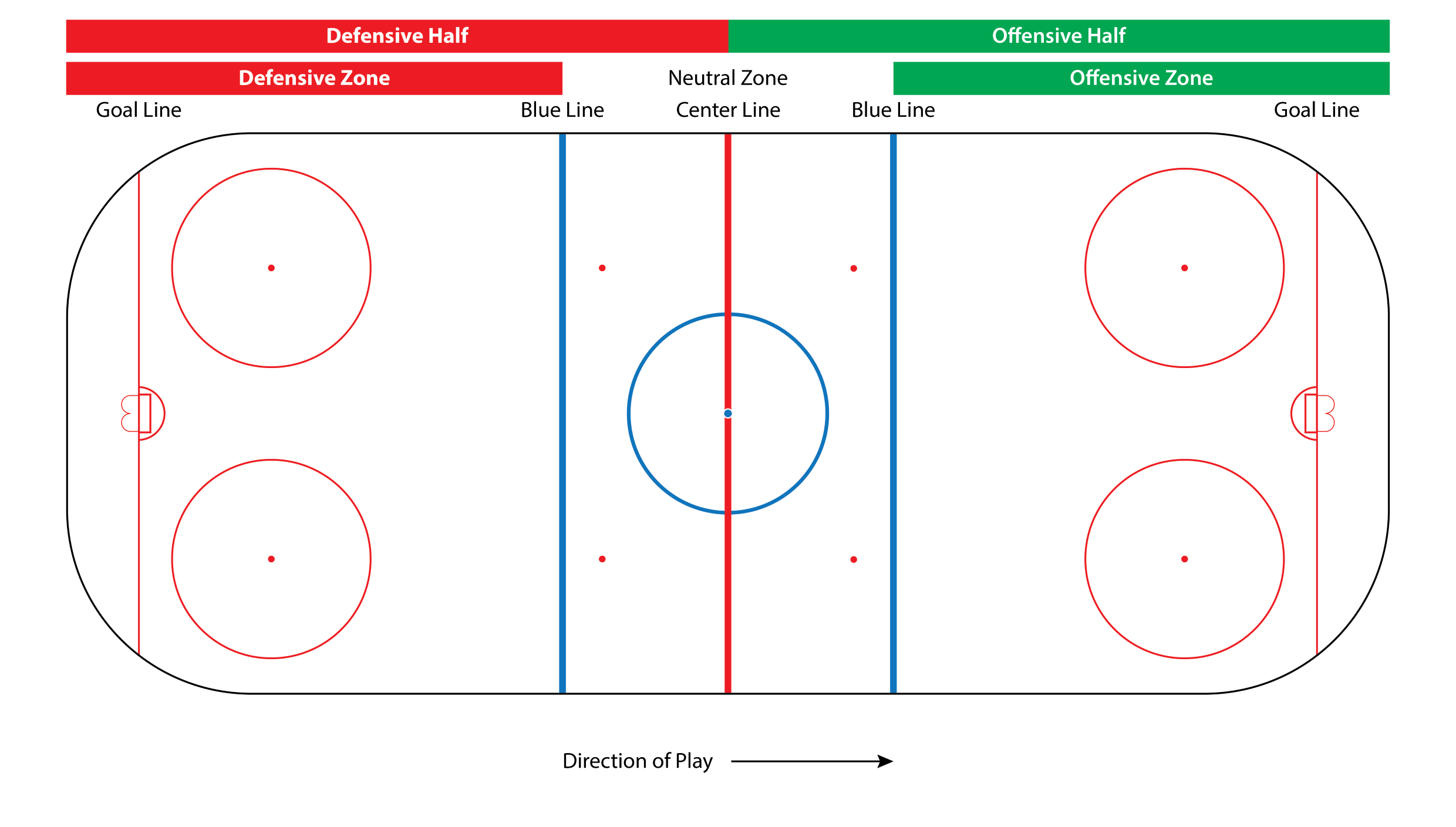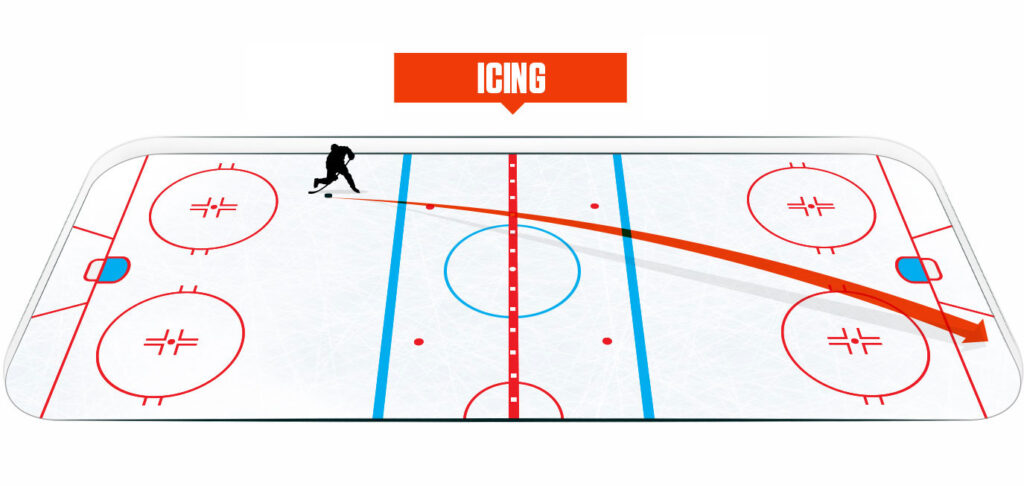What is Icing in Hockey? Icing in hockey occurs when a player shoots the puck across both the centre red line and the opposing goal line without it being touched. It results in a stoppage of play and a face-off in the offending team’s zone.
Icing is a crucial rule in hockey that maintains the flow and fairness of the game. It prevents teams from simply dumping the puck down the ice to relieve pressure or delay the game. Understanding icing helps fans appreciate the strategy involved in puck control and passing.
Coaches and players must be aware of this rule to avoid unnecessary penalties. This rule ensures that teams engage in continuous play and strategic manoeuvring, adding to the excitement and competitiveness of hockey.
Credit: en.wikipedia.org
Introduction To Icing
Hockey is an exciting and fast-paced sport. One key rule every fan should know is icing. This rule helps keep the game fair and enjoyable. Let’s dive into the details.
Definition
Icing happens when a player shoots the puck across both the center red line and the opposing team’s goal line. The puck must not touch another player. This action stops play and results in a face-off in the offending team’s zone.
Origins Of The Rule
The icing rule was introduced in the 1930s. It aimed to prevent teams from simply dumping the puck to relieve pressure. This rule ensures continuous play and fair competition. Over the years, the rule has evolved, but the core idea remains the same.
| Year | Change |
|---|---|
| 1937 | Rule introduced to stop time-wasting. |
| 1970 | Automatic icing introduced in many leagues. |
| 2005 | No-touch icing adopted in some leagues. |
- Icing helps maintain the game’s pace.
- It ensures fair play by preventing easy escapes.
- Face-offs after icing bring excitement to the game.
Understanding icing is essential for every hockey fan. It adds depth to the game and enhances the viewing experience. Now, you can enjoy the game with a better grasp of its rules.
Credit: hersportscorner.com
Basic Rules
Understanding icing in hockey is essential for new fans. The concept helps keep the game fast and fair. Here we explain the basic rules of icing in hockey.
When Icing Occurs
Icing happens when a player shoots the puck across two red lines. These are the center line and the opposing goal line. The puck must go untouched by anyone else.
The referees stop the play when icing occurs. The faceoff then takes place in the defending zone of the team that committed the icing.
Exceptions
| Scenario | Explanation |
|---|---|
| Shorthanded Team | If a team is shorthanded, icing is not called against them. |
| Goalie Interaction | If the goalie touches the puck before it crosses the goal line, icing is waved off. |
| Player Touch | If a player from the defending team touches the puck before it crosses the goal line, icing is nullified. |
These exceptions keep the game fair and dynamic. Knowing them helps you understand why icing is or isn’t called.
Impact On Gameplay
Icing is a crucial rule in hockey that significantly influences gameplay. It affects team strategies, tactics, and overall match dynamics. Understanding its impact can enhance your appreciation for the sport.
Strategic Elements
Icing forces teams to rethink their strategies. Teams cannot change players after an icing call. This rule tests their endurance and stamina.
Coaches must plan line changes carefully. They need to avoid unnecessary icing. Icing can lead to defensive zone face-offs. This gives the opposing team an advantage.
Here’s a table summarizing the strategic elements affected by icing:
| Strategic Element | Impact of Icing |
|---|---|
| Line Changes | Limited due to icing rules |
| Face-offs | More defensive zone face-offs |
| Player Stamina | Increased fatigue |
Team Tactics
Teams use specific tactics to manage icing. They may dump the puck to relieve pressure. This is called a “dump and chase” strategy.
Another tactic involves maintaining puck possession. This reduces the chance of icing. Teams also practice efficient line changes. They do this to keep players fresh.
Here is an unordered list of common team tactics related to icing:
- Dump and chase strategy
- Maintaining puck possession
- Efficient line changes
- Strong defensive play
Teams aim to avoid icing to prevent disadvantages. Proper tactics can turn a risky situation into an opportunity.
Credit: icehockeyguide.com
Enforcement
Understanding the enforcement of icing in hockey is crucial. It ensures the game stays fair and competitive. Icing happens when a player shoots the puck across both the center red line and the opposing team’s goal line without the puck being touched. The enforcement of this rule involves stopping play and bringing the faceoff back to the offending team’s defensive zone. Let’s explore how referees signal icing and the penalties associated with it.
Referee Signals
Referees use specific signals to indicate icing. The most common signal involves the referee raising one arm above their head. This alerts players and fans that icing is being called. Once the puck crosses the goal line, the linesman blows the whistle to stop play. The faceoff then occurs in the defensive zone of the team that committed the icing.
Penalties
Icing itself does not result in a direct penalty. But it comes with consequences. The team that commits icing cannot change players before the next faceoff. This can lead to tired players on the ice, providing an advantage to the opposing team.
Additionally, repeated icing can lead to more strategic disadvantages. Coaches often use these opportunities to apply pressure. It’s important for teams to avoid icing to maintain control and momentum in the game.
Types Of Icing
Understanding the different types of icing is crucial for any hockey fan. Icing can impact the flow of the game. It can also affect team strategies. There are two main types of icing: Touch Icing and No-Touch Icing. Let’s dive into each type.
Touch Icing
Touch Icing requires a defending player to touch the puck first. If the puck crosses the goal line without being touched, the referee stops play. This rule adds an element of chase to the game.
- The defending player must reach the puck first.
- If the attacking player touches first, play continues.
- This rule can lead to thrilling races for the puck.
Touch Icing increases the game’s excitement. Players often race to avoid the icing call. This can lead to collisions and intense moments.
No-touch Icing
No-Touch Icing stops play as soon as the puck crosses the goal line. The defending player does not need to touch the puck. This rule is designed to reduce the risk of injury.
- Play stops once the puck crosses the goal line.
- There is no need for a defending player to touch the puck.
- This rule helps to prevent dangerous collisions.
No-Touch Icing is often seen in youth and amateur leagues. It makes the game safer for all players. It also speeds up the pace of the game.
Historical Changes
The icing rule in hockey has a rich history. The rule has evolved to improve the game’s fairness and safety. Understanding these changes helps appreciate the game’s current state.
Rule Evolution
The icing rule has seen many changes. Initially, icing was not part of the game. It was introduced to stop teams from dumping the puck across the rink. Early rules allowed icing from any part of the ice. This led to slow and defensive games.
Over time, the rule was adjusted. The red line was introduced as a limit. Players could only ice the puck from their side of the red line. This change encouraged more strategic plays and faster games.
Notable Amendments
Many notable amendments have shaped the icing rule. In 1937, the NHL officially adopted the icing rule. This was to reduce stalling tactics. In 1951, the touch icing rule was introduced. Players had to touch the puck first to stop the play.
In 2013, the NHL introduced hybrid icing. This rule aimed to reduce injuries. It combined touch icing with automatic icing, creating a safer game. Players now race to the face-off dots instead of the puck itself.
| Year | Amendment | Purpose |
|---|---|---|
| 1937 | Official adoption of icing | Reduce stalling |
| 1951 | Touch icing | Increase fairness |
| 2013 | Hybrid icing | Reduce injuries |
These amendments highlight the need for a fair and safe game. They show how rules change to meet the sport’s evolving demands.
- 1937: Icing rule officially adopted
- 1951: Touch icing introduced
- 2013: Hybrid icing implemented
Each change brought significant improvements. This makes the game of hockey more exciting and safer for players.
Controversies
Icing in hockey has always sparked debates among fans and players. The rule, intended to keep the game fair and fast, sometimes causes confusion and disputes.
Debates
Many argue about the fairness of the icing rule. Some believe it slows the game down. Others think it prevents strategic plays. Coaches often debate whether to touch up or have automatic icing. Touch icing requires a player to reach the puck first. Automatic icing stops play immediately when the puck crosses the line. Both methods have their pros and cons.
Famous Incidents
Several memorable games have seen controversial icing calls. In one famous incident, a game-winning goal was disallowed due to an icing call. The fans were outraged, and the debate continues to this day. Another case saw a team lose a crucial playoff game because of a missed icing call. These incidents highlight the rule’s impact on the game.
| Incident | Outcome | Reaction |
|---|---|---|
| Disallowed Goal | Game Lost | Fan Outrage |
| Missed Icing Call | Playoff Loss | Ongoing Debate |
Understanding these controversies helps fans appreciate the complexities of the game. The icing rule, while contentious, remains a vital part of hockey.
Icing In Different Leagues
Icing in hockey is a rule that varies across leagues. Understanding these differences is key for fans and players. Here, we will explore how icing is treated in the NHL and International Play.
NHL
In the NHL, icing occurs when a player shoots the puck from behind the center red line. The puck must cross the opponent’s goal line without being touched. If this happens, play stops, and a face-off occurs in the offending team’s zone.
There are exceptions to this rule:
- The team that iced the puck is shorthanded.
- The puck touches any player, including the goalie.
The NHL uses “hybrid icing.” This means the linesman can call off icing if a defending player reaches the face-off dots first.
International Play
Icing rules differ slightly in international play. The International Ice Hockey Federation (IIHF) governs these games. In IIHF rules, icing is automatic. This means play stops as soon as the puck crosses the goal line.
There are also exceptions:
- The offending team is shorthanded.
- The puck touches an opponent.
In international play, there is no “hybrid icing.” This makes the game a bit different from the NHL.
Understanding these differences is important for fans and players. Knowing the rules helps to enjoy the game more.
Training And Avoidance
Understanding icing in hockey is crucial for players and coaches. It’s important to know how to train and avoid it. This section covers strategies and techniques that help avoid icing.
Coaching Strategies
Coaches play a key role in preventing icing. They must train players to recognize and avoid potential icing situations.
- Positioning Drills: Teach players the importance of positioning.
- Communication: Emphasize the need for clear communication on the ice.
- Game Scenarios: Simulate game scenarios to practice avoiding icing.
Player Techniques
Players need to develop specific techniques to avoid icing. They should focus on improving their skating and passing skills.
- Effective Passing: Make strong, accurate passes to avoid icing.
- Quick Decision-Making: React quickly to changing game situations.
- Speed: Use speed to get to the puck before it crosses the goal line.
| Technique | Description |
|---|---|
| Effective Passing | Make strong, accurate passes to avoid icing. |
| Quick Decision-Making | React quickly to changing game situations. |
| Speed | Use speed to get to the puck before it crosses the goal line. |
Frequently Asked Questions
What’s The Point Of Icing In Hockey?
Icing in hockey stops play when a player shoots the puck across both the center red line and the opposing goal line without it being touched. It prevents teams from simply dumping the puck to relieve pressure.
What Is The Penalty For Icing?
The penalty for icing results in a face-off in the offending team’s defensive zone. No player can change lines.
Why Do Goalies Put Their Arm Up For Icing?
Goalies raise their arm to signal icing, alerting officials and teammates. It helps prevent unnecessary play and confusion.
What Is Icing And Offsides In Hockey?
Icing occurs when a player shoots the puck across both the center red line and the opposing goal line. Offsides happens when a player enters the attacking zone before the puck.
Conclusion
Understanding icing in hockey enhances your appreciation of the game. This key rule keeps play fast and fair. By knowing the basics, you can enjoy watching or playing hockey even more. Stay informed and enjoy the dynamic world of hockey with a deeper knowledge of its rules.






